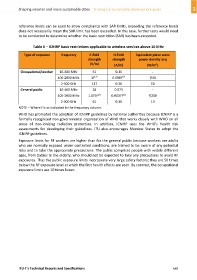Page 653 - Shaping smarter and more sustainable cities - Striving for sustainable development goals
P. 653
reference levels can be used to show compliance with SAR limits, exceeding the reference levels
does not necessarily mean the SAR limit has been exceeded. In this case, further tests would need
to be conducted to determine whether the basic restriction (SAR) has been exceeded.
Table 6 – ICNIRP basic restrictions applicable to wireless services above 10 MHz
Type of exposure Frequency E‐field H‐field Equivalent plane wave
strength strength power density Seq
(V/m) (A/m) (W/m )
2
Occupational/worker 10‐400 MHz 61 0.16 ‐
1/2
1/2
400‐2000 MHz 3f 0.008f f/40
2‐300 GHz 137 0.36 50
General public 10‐400 MHz 28 0.073 ‐
1/2
1/2
400‐2000 MHz 1.375f 0.0037f f/200
2‐300 GHz 61 0.16 10
NOTE – Where f is as indicated in the frequency column.
WHO has promoted the adoption of ICNIRP guidelines by national authorities because ICNIRP is a
formally recognized non‐governmental organization of WHO that works closely with WHO on all
areas of non‐ionizing radiation protection. In addition, ICNIRP uses the WHO's health risk
assessments for developing their guidelines. ITU also encourages Member States to adopt the
ICNIRP guidelines.
Exposure limits for RF workers are higher than for the general public because workers are adults
who are normally exposed under controlled conditions, are trained to be aware of any potential
risks and to take the appropriate precautions. The public comprises people with widely different
ages, from babies to the elderly, who should not be expected to take any precautions to avoid RF
exposures. Thus the public exposure limits incorporate very large safety factors; they are 50 times
below the RF exposure level at which the first health effects are seen. By contrast, the occupational
exposure limits are 10 times lower.
ITU‐T's Technical Reports and Specifications 643

